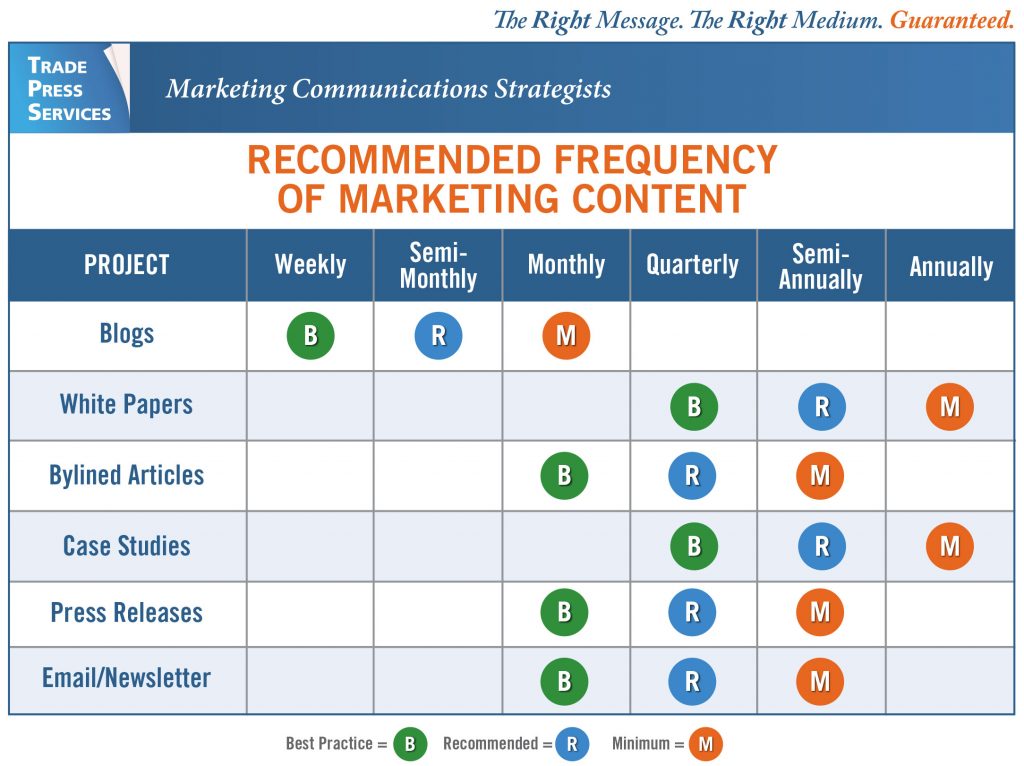
Content creation is a must for any business to increase brand awareness. It’s also an important method for communicating with your customers and prospects. In fact in a survey of marketers, 86% of marketers report they are planning to increase the amount of content they publish in 2018.
Generating marketing content and distributing it appropriately showcases your relevant industry expertise. In a pivotal way, it positions your organization as a leader in the marketplace. Whether content takes the form of blogs, press releases, case studies or other types of communications projects, communicating more is often better. But how often should you reach out? Which channels require more frequency? Is there a standard of best practices?
As experts in B2B marketing, we know how to maximize various methods of outreach. The following are our recommendations for frequency of marketing content as part of an overall marketing strategy.
Communicating: Frequency of Marketing Content

As you think about your internal resources including time, money, and personnel, you might be wondering which communications projects are right for you. Here is a brief description of each one to help you in your planning efforts.
- Blogs should consist of relevant industry themes, but don’t be afraid to explore a wide range of topics or even take a more playful approach. Show your brand’s personality and keep blogs short, sweet and highly readable. Because of their flexibility, most agree that posting blogs as much as possible will give you an edge. Blogging weekly is ideal. However, posting consistently once or twice a month will maintain a brand-aligned frequency of contact with your audiences.
- White papers offer an in-depth exploration of an industry theory, trend or issue and demonstrate how your company offers a solution. A white paper should showcase your organization’s expertise and offer groundbreaking insights. Due to their comprehensive nature—the suggested length is 5-12 pages—white papers take some time, but should be developed consistently to affirm your company’s status as an expert.
- Bylined articles, another expression of thought leadership, are important due to their reach to decision-makers in your target industries. Getting published in trade magazines introduces your firm and its thought leaders to new audiences. Again, topics should be industry- and brand-relevant. Due to the nature of the publishing process, content frequency should be a minimum of semi-annually, but with a goal of appearing monthly.
- Case studies bring your company’s success to life by telling the story of how your product or service has helped customers. Case studies boost customer and prospect confidence, elevate trust and demonstrate the value of your solutions. Also, 78 percent of buyers seek out case studies during the purchasing process. Case studies should be completed based on valued successes, but aim to showcase at least two projects a year.
- Press releases announce recent organizational changes, new products or services, special events and other initiatives. To capture the attention of editors and journalists, press releases need to be timely and newsworthy. Keeping your clients, investors, employees and prospects informed is a necessity of a firm. Press releases also serve as a valuable marketing and business development tool. Keep your audiences informed at least quarterly, but be sure to release news and updates while they are fresh.
- Email newsletters deliver relevant information directly to your target audiences’ inboxes. In addition to demonstrating thought leadership, newsletters boost brand awareness and provide valuable feedback about levels of engagement with prospects and customers. Savvy B2B marketers generate newsletters monthly, but be sure to produce them at least quarterly to stay top-of-mind with your contacts.
Create a Communications Content Schedule

Of course, content frequency doesn’t end with these communications projects. Don’t forget about initiatives such as social media posts, e-books, press kits, infographics and more. There are also countless methods that aren’t text-based. These include presentations, webinars, events and speaking engagements. Start by using this matrix to assess your company’s frequency of contact with prospects and customers via marketing content. Then, take your outreach a step further. Consistency is important when it comes to creating a marketing plan that works for your team and a content schedule for communicating with prospects and customers. Ultimately, this helps accomplish critical organizational goals.
